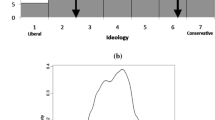Abstract
Richard McKelvey predicts that candidates will converge to an equilibrium if candidates and voters maximize their utility and voters' preferences conform to stringent assumptions. Although there are discrepancies between electoral data and the requirements of the theory, an analysis of 1972 and 1976 survey data lends support to basic components of the theory. First, most voters did choose the candidate who provided the greater utility. Second, voter distribution was not asymmetrical enough to allow a candidate to win by moving away from the median toward a concentration of voters. Third, the winning strategy for a candidate was to locate at or near the median. While formal theories' predictions will not hold in their precisely stated form, the assumptions can be robust enough to offer an explanation of electoral choices.
Similar content being viewed by others
References
Aldrich, John H. (1977). Electoral choice in 1972: a test of some theories of the spatial model of electoral competition.Journal of Mathematical Sociology 5: 215–237.
Aldrich, John H., and McKelvey, Richard D. (1977). A method of scaling with applications to the 1968 and 1972 presidential elections.American Political Science Review 71: 111–130.
Brody, Richard A., and Page, Benjamin I. (1976). The assessment of policy voting. In Richard G. Niemi and Herbert F. Weisberg (eds.),Controversies in American Voting Behavior. San Francisco: W. H. Freeman.
Cahoon, Lawrence, Hinich, Melvin J., and Ordeshook, Peter C. (1978). A statistical multidimensional scaling method based on the spatial theory of voting. In P. C. Wang (ed.),Graphical Representation of Multivariate Data. New York: Academic Press.
Davis, Otto A., Hinich, Melvin J., and Ordeshook, Peter C. (1970). An expository development of a mathematical model of the electoral process.American Political Science Review 64: 426–448.
Davis, Sandra K. (1984). A nonmetric test of spatial theories of elections.Political Methodology 10: 1–27.
Downs, Anthony (1957).An Economic Theory of Democracy. New York: Harper & Row.
Enelow, James M., and Hinich, Melvin J. (1984).The Spatial Theory of Voting. New York: Cambridge University Press.
Enelow, James M., and Hinich, Melvin J. (1982). Nonspatial candidate characteristics and electoral competition.Journal of Politics 44: 115–130.
Fiorina, Morris P. (1975). Formal models in political science.American Journal of Political Science 19: 133–159.
Fiorina, Morris P. (1977). An outline for a model of party choice.American Journal of Political Science 21: 601–623.
Hinich, Melvin J. (1978). Some evidence on non-voting in the spatial theory of electoral competition.Public Choice 33: 83–102.
Kessel, John (1980).Presidential Campaign Politics. Homewood, Ill.: Dorsey Press.
Markus, Gregory, and Converse, Philip E. (1979). A dynamic simultaneous equation model of electoral choice.American Political Science Review 73: 1055–1070.
McKelvey, Richard D. (1975). Policy related voting and electoral equilibrium.Econometrica 43: 815–843.
Niemi, Richard G., and Weisberg, Herbert F. (1976). Parties, candidates, or issues? In Richard G. Neimi and Herbert F. Weisberg (eds.),Controversies in American Voting Behavior. San Francisco: W. H. Freeman.
Poole, Keith T., and Rosenthal, Howard (1984). US presidential elections 1960–80: a spatial analysis.American Journal of Political Science 28: 282–312.
Popkin, Samuel, Gorman, John W., Phillips, Charles, and Smith, Jeffrey A. (1976). Comment: What have you done for me lately? Toward an investment theory of voting.American Political Science Review 70: 779–803.
Rabinowitz, George B. (1978). On the nature of political issues: insights from a spatial analysis.American Journal of Political Science 22 (November): 793–817.
Rabinowitz, George B. (1975). An introduction to nonmetric multidimensional scaling.American Journal of Political Science 19: 343–390.
Rabinowitz, George B. (1973).Spatial Models of Electoral Choice: An Empirical Analysis. Chapel Hill, N.C.: Institute for Research in Social Science.
Riker, William H., and Ordeshook, Peter C. (1973).An Introduction to Positive Political Theory. Englewood Cliffs, N.J.: Prentice-Hall.
Steeper, Frederick T., and Teeter, Robert M. (1976). Comment on “A majority party in disarray.”American Political Science Review 70: 804–809.
Wittman, Donald (1983). Candidate motivation: a synthesis of alternative theories.American Political Science Review 77: 142–157.
Author information
Authors and Affiliations
Rights and permissions
About this article
Cite this article
Davis, S. A test of candidate equilibrium. Polit Behav 9, 29–48 (1987). https://doi.org/10.1007/BF00987277
Issue Date:
DOI: https://doi.org/10.1007/BF00987277



